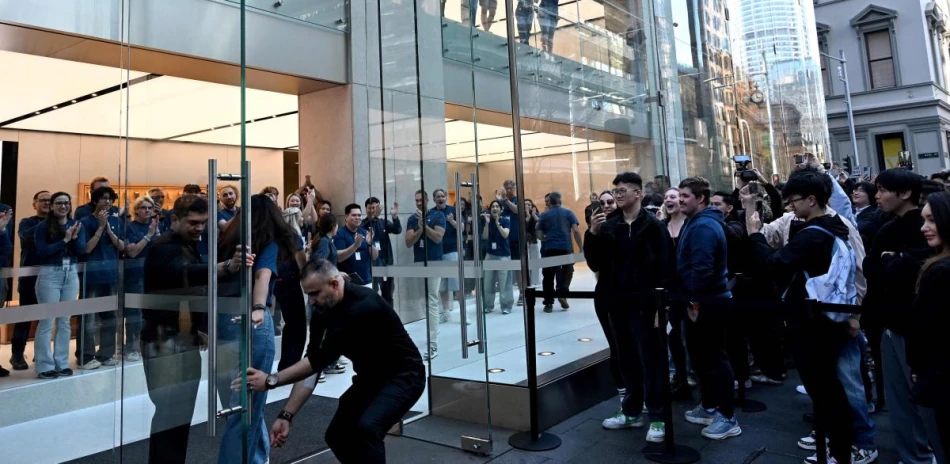
Eager Crowds Await iPhone 17 Launch: Apple Bets on Sleek New Design
Apple's Design Gamble: iPhone 17 Launch Tests Consumer Appetite After Four-Year Wait
Apple is betting big on design refresh as the iPhone 17 Pro, Pro Max, and the ultra-thin iPhone Air hit global markets, marking the company's first major design overhaul since 2020. Early sales data from Asia reveals strong demand for Pro models but concerning supply constraints, with delivery times stretching up to four weeks—a critical test for Apple as it faces mounting pressure from Wall Street and intensifying competition from Samsung and Chinese manufacturers.
Global Launch Reveals Supply Bottlenecks
The familiar ritual of Apple store queues unfolded across Asia on Friday, but this time with a twist. In Hong Kong, Apple's flagship store could only display the iPhone Air for hands-on testing, directing customers online for Pro model purchases. This pattern repeated across Australia, New Zealand, China, and Singapore, where the iPhone 17 Pro Max showed four-week delivery delays.
Only Japan bucked the trend, offering next-day delivery for all models, while South Korea positioned itself as a middle ground with one-week availability for the Pro and late October for the Pro Max. These supply constraints suggest either stronger-than-expected demand or production challenges—both scenarios carry significant implications for Apple's quarterly performance.
Design Revolution After Years of Stagnation
The iPhone 17 Pro series returns to aluminum construction with a redesigned back panel, addressing years of consumer complaints about design stagnation. More intriguingly, the iPhone Air represents Apple's boldest design experiment in recent memory, prioritizing ultra-thin aesthetics over traditional performance metrics.
This design philosophy mirrors Samsung's approach with the Galaxy S25 Edge, launched earlier this year with similar ultra-thin positioning but lackluster sales performance. Apple's execution will determine whether the premium smartphone market is ready for form-over-function devices.
China Challenge Intensifies Competitive Pressure
Apple's performance in China will serve as the ultimate litmus test for these new models. The company's market share has plummeted to just 12%, trailing domestic champions Oppo, Huawei, and Xiaomi. More troubling, iPhone sales dropped 6% in the weeks preceding the launch—an unusual decline that signals weakening brand loyalty in Apple's second-largest market.
This erosion comes as Chinese consumers increasingly embrace local alternatives offering comparable features at lower prices, often with faster 5G implementations and AI capabilities tailored to local preferences. Apple's premium positioning, once unassailable in China, now faces its sternest test.
Market Dynamics and Investor Implications
The iPhone 17 Pro's $1,099 starting price represents a modest $100 increase over its predecessor, but the real revenue opportunity lies in the upgrade cycle dynamics. John Belton from Gabelli Funds, managing $33 billion in assets, notes that meaningful price increases combined with a typical replacement cycle could drive substantial revenue growth, even if AI features remain incremental.
However, the iPhone Air presents a more complex value proposition. At $999, it matches the iPhone 17 Pro's price when factoring in the optional magnetic battery pack needed to address its inherent battery life limitations. This pricing strategy suggests Apple is testing market segmentation rather than pursuing volume growth.
Competitive Landscape Shifts
Samsung's seventh-generation foldable phone has gained significant consumer traction with improved durability and refined aesthetics, highlighting Apple's absence in the foldable category. Bloomberg reports Apple won't enter this space until late next year, ceding valuable market positioning time to competitors.
Meanwhile, Meta and other tech giants pivot toward AI-powered wearables, including smart glasses with integrated displays. This trend suggests the smartphone's evolutionary peak may be approaching, making Apple's design refresh both timely and potentially insufficient for long-term differentiation.
Strategic Implications Beyond Hardware
Apple's latest launch coincides with broader industry uncertainty about AI implementation and consumer adoption patterns. The company's AI strategy has underperformed expectations, making hardware innovation crucial for maintaining premium pricing power.
The success of these models will determine whether Apple can sustain its services revenue growth trajectory and justify its market valuation amid global economic headwinds and potential tariff-related cost pressures. Early supply constraints suggest strong initial demand, but sustained momentum will depend on real-world performance reviews and competitive responses in the critical holiday selling season.
 Omar Rahman
Omar Rahman







